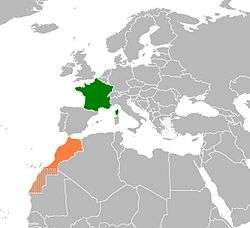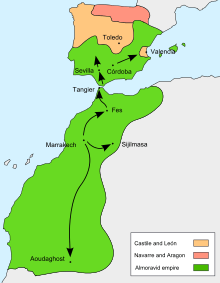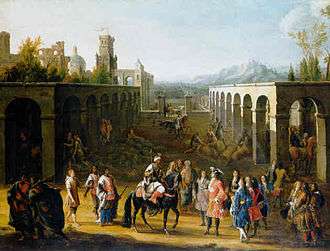France–Morocco relations
 | |
France |
Morocco |
|---|---|
France–Morocco relations are bilateral relations between Morocco and France. They are part of France-Africa relations.
First exchanges (8th century)

Following the invasion of Spain from the coast of Morocco by the Berber Commander Tariq ibn Ziyad in 711, during the 8th century Arab and Berber armies invaded Southern France, as far as Poitiers and the Rhône valley as far as Avignon, Lyon, Autun, until the turning point of the Battle of Tours in 732.[1]
Cultural exchanges followed. In the 10th century, the French monk Gerbert d'Aurillac, who became the first French Pope Sylvester II in 999, traveled to Spain to learn about Islamic culture, and may even have studied at the University of Al-Qarawiyyin in Fes, Morocco.[2]
France would become again threatened by the proximity of the expanding Almoravid Empire in the 11th and 12th centuries.[3]
Consuls and physicians (1577-1600)

In 1402, the French adventurer Jean de Béthencourt left La Rochelle and sailed along the coast of Morocco to conquer the Canary islands.[4]
In the 16th century, the sealing of a Franco-Ottoman alliance between Francis I and Suleiman the Magnificent permitted numerous contacts between French traders and countries under Ottoman influence. In 1533, Francis I sent as ambassador to Morocco, colonel Pierre de Piton.[5] In a letter to Francis I dated August 13, 1533, the Wattassid ruler of Fes, Ahmed ben Mohammed, welcomed French overtures and granted freedom of shipping and protection of French traders. France started to send ships to Morocco in 1555, under the rule of Henry II, son of Francis I.[6]
France, under Henry III, established a Consul in Fes, Morocco, as early as 1577, in the person of Guillaume Bérard, and was the first European country to do so.[7][8] Under Henry, France named the first Consul of France in Morocco in the person of Guillaume Bérard. Bérard, a doctor by profession, had saved the life of the Moroccan prince Abd al-Malik, during an epidemic in Istanbul; when he came to the Moroccan throne, bd al-Malik wished to retain Bérard in his service.[9]
Bérard was succeeded by Arnoult de Lisle and then Étienne Hubert d'Orléans in the double position of physician and representative of France at the side of the Sultan. These contacts with France occurred during the landmark rules of Abd al-Malik and his successor, Moulay Ahmad al-Mansur.
This was a time also when England was trying to establish friendly relations as well, in view of an Anglo-Moroccan alliance, with the visit of Edmund Hogan to Muley Abd el-Malek in 1577.[8]
Moroccan missions to France
The first Moroccan mission to France would be that of Al-Hajari in 1610-11, who was sent to Europe by the Moroccan ruler to obtain redress against the ill-treatment of the Moriscos.[10] Soon after, Ahmed el-Guezouli visited France in 1612-1613. He first went with Nasser Carta to the Netherlands, where he obtained the intercession of the States General for a visit to France; and then to France where he endeavoured to obtain the restitution of the library of Moulay Zidane, which had been taken by Jean Philippe de Castelane.
Expeditions of Isaac de Razilly (1619-1631)

Isaac de Razilly, accompanied by Claude du Mas, already sailed to Morocco in 1619, under the orders of Louis XIII who was considering a colonial venture in Morocco.[11] He was able to reconnoiter the coast as far as Mogador. They returned to France accompanied by an envoy in the person of caid Sidi Farès, whose mission was to take the books of Mulay Zidan back.
In 1624, Razilly was put in charge of an embassy to the pirate harbor of Salé in Morocco, in order to again solve the affair of the library of Mulay Zidan. He was imprisoned and put under chains before being released, although he had to leave many Christian captives behind.[12] The mission of Razilly was accompanied by the first Capuchins to establish themselves in Morocco.[13]
As Richelieu and Père Joseph were attempting to establish a colonial policy, Razilly suggested them to occupy Mogador in Morocco in 1626. The objective was to create a base against the Sultan of Marrakesh, and asphyxiate the harbor of Safi. He departed for Salé on 20 July 1629 with a fleet composed of the ships Licorne, Saint-Louis, Griffon, Catherine, Hambourg, Sainte-Anne, Saint-Jean. He bombarded the city the Salé and destroyed 3 corsair ships, and then sent the Griffon under Treillebois to Mogador. The men of Razilly saw the fortress of Castelo Real in Mogador, and landed 100 men with wood and supplies on Mogador island, with the agreement of Richelieu. After a few days however, the Griffon reembarked the colonists, and departed to rejoin the fleet in Salé.[14]
In 1630, Razilly was able to negotiate the purchase of French slaves from the Moroccans. He visited Morocco again in 1631, and participated to the negotiation of the Franco-Moroccan Treaty of 1631, with the help of descendants of Samuel Pallache (see Pallache family).[15] The Treaty give France preferential treatment, known as Capitulations: preferential tariffs, the establishment of a Consulate and freedom of religion for French subjects.[16]
Alliances
Early embassies


As early as the 17th century, Moulay Ismaïl, who was looking for allies against Spain, had excellent relations with Louis XIV of France. He sent to the Sun-King ambassador Mohammad Temim in 1682. There was cooperation in several fields. French officers trained the Moroccan army and advised the Moroccans in the building of public works. French Consuls in Morocco were assigned, such as Jean-Baptiste Estelle. The French ambassador François Pidou de Saint Olon, was sent by Louis XIV visited Moulai Ismael in 1693. The Ambassador of Morocco Abdallah bin Aisha also visited Paris in 1699.


Collaboration
After the end of the Seven Years' War, France turned its attention to Barbaresque pirates, especially those of Morocco, who had taken advantage of the conflict to attack Western shipping.[17] The French fleet failed in the Larache expedition in 1765.[17]
Some contacts continued during the 18th century, as when the French engineer Théodore Cornut designed the new harbour of Essaouira for King Mohammed ben Abdallah from 1760. In 1767, France established a treaty with Morocco, which gave her consular and diplomatic protection. This treaty would become a model for other European powers for the following years.[7]
In 1777, Mohammed ben Abdallah further sent an embassy to Louis XVI, led by Tahar Fennich and Haj Abdallah. The embassy brought as presents 20 French slaves previously captured in Provence by the pirates of Salé, as well as 6 magnificent horses. The two ambassadors remained in France for 6 months.[18]
Another Moroccan embassy to France in 1781 was sent, but failed to be recognized on the pretext that the title of the king of France had not been properly rendered.
Industrial era
First Franco-Moroccan War

After the troubled periods of the French Revolution and the Napoleonic Wars, France again showed a strong interest in Morocco in the 1830s, as a possible extension of her sphere of influence in the Maghreb, after Algeria and Tunisia. The First Franco-Moroccan War took place in 1844, as a consequence of Morocco's alliance with Algeria's Abd-El-Kader against France. Following several incident at the border between Algeria and Morocco, and the refusal of Morocco to abandon its support to Algeria, France faced Morocco victoriously in the Bombardment of Tangiers (August 6, 1844), the Battle of Isly (August 14, 1844), and the Bombardment of Mogador (August 15–17, 1844).[19] The war was formally ended September 10 with the signing of the Treaty of Tangiers, in which Morocco agreed to arrest and outlaw Abd-El-Kader, reduce the size of its garrison at Oujda, and establish a commission to demarcate the border. The border, which is essentially the modern border between Morocco and Algeria, was agreed in the Treaty of Lalla Maghnia.
Second Franco-Moroccan War
The United Kingdom recognized France's "sphere of influence" in Morocco in the 1904 Entente Cordiale. This provoked a German reaction, and the "crisis" of 1905-1906 was resolved at the Algeciras Conference in 1906, formalizing France's "special position" and entrusted policing of Morocco jointly to France and Spain. A second "Moroccan crisis" provoked by Berlin, increased European Great Power tensions, but the Treaty of Fez (signed on March 30, 1912) made Morocco a protectorate of France. From a strictly legal point of view, the treaty did not deprive Morocco of its status as a sovereign state.
In late 1955, Mohammed V successfully negotiated the gradual restoration of Moroccan independence within a framework of French-Moroccan interdependence.
Modern times

France remains the primary trade partner (supplier and customer) of Morocco. France is also the primary creditor and foreign investor in Morocco. Moroccans do also invest in France, as the Royal Moroccan Airforce has a good trust in French aeronautical technologies.
Today the relations between the republic of France and the kingdom of Morocco remains very friendly and based mainly on trade and tourism. One of them is the fact that King Mohammed VI chose France as his first state visit and the French President returned the favor. Furthermore, France signed documents to build a high speed train line in Morocco.[20]
The Morocco national football team announced a squad of 10 French-born players during the 2013 Africa Cup of Nations.
Famous French-Moroccans
Notes and references
- ↑ Tricolor and crescent: France and the Islamic world by William E. Watson p.1
- ↑ The Champions of Change Dr. Allah Bakhsh Malik p.29ff
- ↑ Reconquest and crusade in medieval Spain by Joseph F. O'Callaghan p.31
- ↑ Canary Islands by Sarah Andrews, Josephine Quintero p.25
- ↑ "Francois I, hoping that Morocco would open up to France as easily as Mexico had to Spain, sent a commission, half commercial and half diplomatic, which he confided to one Pierre de Piton. The story of his mission is not without interest" in The conquest of Morocco by Cecil Vivian Usborne, S. Paul & co. ltd., 1936, p.33
- ↑ Travels in Morocco, Volume 2 James Richardson p.32
- 1 2 The International City of Tangier, Stuart, p.38
- 1 2 Studies in Elizabethan Foreign Trade p.149
- ↑ Garcés, María Antonia. ''Cervantes in Algiers: a captive's tale''. Google Books. p. 277 note 39.
- ↑ The mirror of Spain, 1500-1700: the formation of a myth by J. N. Hillgarth
- ↑ "The narrative really begins in 1619, when the adventurer, Admiral S. John de Razilly, resolved to go to Africa. France had no colony in Morocco; hence, King Louis XIII gave whole-hearted support to de Razilly." in Round table of Franciscan research, Volumes 17-18 Capuchin Seminary of St. Anthony, 1952
- ↑ The chevalier de Montmagny (1601-1657): first governor of New France by Jean-Claude Dubé, Elizabeth Rapley p.111
- ↑ "The first Capuchin missionaries arrived in Morocco in 1624. They were Pierre d'Alencon, Michel de Vezins, priests, and Frère Rudolphe d'Angers a lay-brother. They were attached to the expedition of the seigneur de Razilly who was sent by France to negotiate a trade-treaty." in The Capuchins: a contribution to the history of the Counter-Reformation Father Cuthbert (O.S.F.C.) Sheed and Ward, 1928
- ↑ E.J. Brill's first encyclopaedia of Islam, 1913-1936, Volume 9 by Martijn Theodoor Houtsma p.549
- ↑ A man of three worlds Mercedes García-Arenal, Gerard Albert Wiegers p.114
- ↑ France in the age of Louis XIII and Richelieu by Victor Lucien Tapié p.259
- 1 2 Admiral de Grasse and American independence by Charles A. Lewis, Charles Lee Lewis p.41ff
- ↑ In the lands of the Christians: Arabic travel writing in the seventeenth century by Nabil I. Matar p.191 Note 4
- ↑ Navies in modern world history Lawrence Sondhaus p.71ff
- ↑ http://www.diplomatie.gouv.fr/en/country-files/morocco-285/france-and-morocco/economic-relations-6307/

